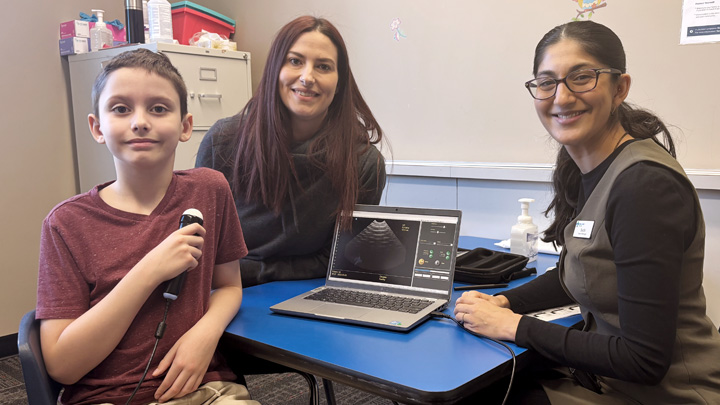
May 21, 2025

After doing some research and gaining access to an ultrasound machine, speech language pathologist Suchi Jobanputra introduced it as a new tool for therapy sessions. One of her clients, Dominic McLean, 9, seen here with mother Jennifer, centre, lives with a severe expressive speech delay, speech sound disorder and apraxia of speech. He’s become a huge fan of the machine which allows him to see his tongue movement and its placement in his mouth. It’s helped him improve his challenges with the letter “R”. Jobanputra reports that some of her clients have noticed a marked improvement after just one session with the ultrasound machine. Photo by Kirsten Goruk.
Story & photo by Kirsten Goruk | Video by Evan Isbister
EDMONTON — Dominic McLean has been in some form of speech language therapy since he was two-years-old.
After being diagnosed at a young age with a severe expressive speech delay and speech sound disorder, Dominic, now nine-years-old, was eventually diagnosed with childhood apraxia of speech — a motor speech disorder that makes it harder for him to plan and coordinate the movements needed for speaking.
When Dominic’s mom Jennifer Benning noticed that he didn’t have a lot of words at two-years-old, she reached out for help. Over the years, that’s involved speech language therapy group classes, support through school, and therapy sessions through Alberta Health Services (AHS).
“We always had a lot of success with Dominic, he was always very dedicated to learning sounds and practising at home, but we got stuck on the sound of the letter “R.” He got discouraged and we had trouble getting him to therapy,” says Benning.
Recognizing their struggles, Suchi Jobanputra, Dominic’s speech language pathologist (SLP), asked if they might be willing to try something new. Last year, Jobanputra’s team with AHS’ community health services got access to an ultrasound machine they could use in therapy for some speech clients. She felt Dominic would be a great candidate.
“During the session the ultrasound probe is placed under the chin. This allows us to get a real-time visual of the tongue, either from the front or the side. As the child speaks, you can see the tongue move, and the SLP can give cues about how and where to place their tongue to say their target sound,” says Jobanputra.
“It gives us a window into a process that is typically hidden.” Dominic’s progress under this new approach has been significant. Jennifer has noticed an increase in his confidence and willingness to speak to others.
“He went from going to school with panic attacks every day because he knew no one understood him. He couldn’t talk to teachers, and felt a lot of frustration. After the ultrasound treatment, I noticed his confidence a lot more,” she says, adding that Dominic also has Level 1 autism and selective mutism, which can add to the challenges he faces.
“When you’re not understood, it’s tough. Watching him make friends is something he didn't do earlier. I’m very proud of him.” For Dominic, the addition of the ultrasound machine has brought an interesting change in his therapy — and he’s seeing his progress happen in real time.
“I used to struggle more with talking, but now it feels easier. Seeing my tongue move on the screen was really cool,” he says.
Dominic is continuing his work on mastering the “R” sound, and also working on his ability to motor plan in therapy.
Meanwhile, Jobanputra’s team recently received research funding to explore the caregiver and SLP perspectives on the use of the ultrasound machine. She says she’s excited about the future possibilities of this approach.
“The speech therapy journey can be a long one for many families, and it can be frustrating when progress is stalled or limited. To have a treatment technique that is effective, efficient and really motivating can be the push some families need to keep working at it.”
Jobanputra adds: “As a healthcare provider, it’s incredibly rewarding to see children, and their parents or caregivers, excited and satisfied with their progress towards communication goals.”
Parents can get more information online about available Pediatric Rehabilitation services — including Speech and Language, Audiology, Early Childhood Supports, Occupational Therapy, and Physical Therapy. They can also call the Rehabilitation Advice Line or contact your local Allied Health team. Families who live in the Edmonton and surrounding areas can call the central intake line at 1-888-925-4044.